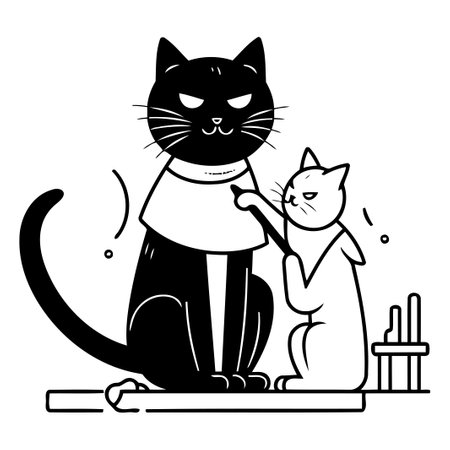1. Understanding Feline Panleukopenia Virus
What is Feline Panleukopenia Virus (FPV)?
Feline Panleukopenia Virus (FPV), also known as feline distemper or feline parvovirus, is a highly contagious and life-threatening disease that affects cats. It primarily targets rapidly dividing cells in the body, leading to severe gastrointestinal, immune system, and bone marrow issues.
Causes of FPV
FPV is caused by a parvovirus that is extremely resilient in the environment. It can survive on surfaces, in litter boxes, and even on human clothing for extended periods. This durability makes it a significant threat to unvaccinated cats.
How FPV Spreads Among Cats
The virus spreads through direct contact with an infected cat or exposure to contaminated objects such as food bowls, bedding, or shared spaces. Additionally, humans can inadvertently transfer the virus via hands, shoes, or clothing.
Main Transmission Methods:
| Transmission Method | Description |
|---|---|
| Direct Contact | Cats can contract FPV by interacting with infected felines. |
| Contaminated Surfaces | The virus can linger on food bowls, litter boxes, and bedding. |
| Human Carriers | People can unknowingly spread the virus via hands, shoes, or clothing. |
| Mother to Kitten | An infected mother can pass the virus to her kittens during pregnancy. |
The Severity of FPV Infection
Cats infected with FPV often experience symptoms such as vomiting, diarrhea, fever, dehydration, and lethargy. In severe cases, especially in kittens or immunocompromised cats, the disease can be fatal. Due to its high mortality rate and rapid spread, vaccination is crucial in preventing outbreaks.
2. Symptoms and Impact on Cats
Common Signs of Infection
Feline Panleukopenia Virus (FPV) can affect cats rapidly, and early signs of infection may not always be obvious. Recognizing the symptoms early can make a significant difference in seeking timely treatment. Here are some common signs to watch for:
| Category | Symptoms |
|---|---|
| Gastrointestinal Issues | Severe vomiting, diarrhea (often bloody), dehydration |
| Behavioral Changes | Lethargy, lack of appetite, hiding |
| Physical Symptoms | Fever, weight loss, rough or unkempt coat |
| Neurological Signs (in severe cases) | Lack of coordination, tremors (especially in kittens) |
Severity of the Disease
The severity of FPV depends on several factors, including the cat’s age, overall health, and immune response. Kittens, unvaccinated cats, and those with weakened immune systems are at the highest risk.
- Kittens: Most vulnerable due to underdeveloped immune systems. The disease can progress rapidly, often leading to fatal outcomes.
- Adult Cats: Unvaccinated adults can still suffer from severe illness but have a slightly better chance of survival with intensive care.
- Pregnant Cats: Infection during pregnancy can result in miscarriage or severe developmental issues in newborn kittens.
Potential Fatal Outcomes if Left Untreated
If left untreated, FPV can lead to devastating consequences. The virus attacks rapidly dividing cells, especially in the bone marrow and intestines, leading to life-threatening conditions such as:
- Pancytopenia: A dangerous drop in white blood cells, red blood cells, and platelets, weakening the immune system.
- Bacterial Infections: Due to a compromised immune system, secondary infections can take hold quickly.
- Inefficient Nutrient Absorption: Severe intestinal damage prevents proper nutrient absorption, worsening weakness and dehydration.
- Sudden Death: In some cases, especially in young kittens, FPV can cause sudden death even before noticeable symptoms appear.
The high mortality rate associated with FPV makes vaccination the best line of defense. Since treatment options are limited and primarily supportive rather than curative, prevention through vaccination is crucial for all cats.

3. How FPV Is Diagnosed and Treated
Methods Veterinarians Use to Diagnose FPV
Feline Panleukopenia Virus (FPV) can be tricky to diagnose because its symptoms resemble other feline illnesses. Veterinarians use a combination of clinical signs, medical history, and diagnostic tests to confirm an infection. Below are the primary methods used:
Common Diagnostic Methods
| Diagnostic Method | Description |
|---|---|
| Physical Examination | The vet checks for fever, dehydration, lethargy, and other common symptoms. |
| Blood Tests (CBC) | A complete blood count (CBC) often reveals a dangerously low white blood cell count, a key indicator of FPV. |
| Fecal ELISA Test | A test designed to detect FPV antigens in the cat’s stool. |
| Polymerase Chain Reaction (PCR) Test | A highly sensitive test that identifies FPV DNA in feces or blood samples. |
| Virus Isolation | A lab-based method used in rare cases to grow and identify the virus. |
Treatment Options for FPV
Unfortunately, there is no direct cure for FPV. Treatment focuses on supportive care to help the cats immune system fight the virus and recover. The sooner treatment begins, the better the chances of survival.
Supportive Care Measures
- Fluid Therapy: Cats with FPV often suffer from severe dehydration due to vomiting and diarrhea. IV fluids help restore electrolyte balance.
- Nutritional Support: Cats may refuse to eat, so assisted feeding or appetite stimulants may be necessary.
- Antibiotics: While antibiotics don’t kill viruses, they help prevent secondary bacterial infections caused by the weakened immune system.
- Anti-Nausea Medication: Helps control vomiting and improves nutrient absorption.
- Hospitalization: Many FPV-positive cats require isolation and intensive care in a veterinary hospital.
The Importance of Early Detection and Treatment
Catching FPV early significantly improves a cat’s chances of survival. If you suspect your cat has been exposed or is showing symptoms such as persistent vomiting, diarrhea, or extreme lethargy, seek veterinary care immediately. Timely intervention can make all the difference in recovery.
4. The Importance of Vaccination
Why Vaccinating Cats Against FPV Is Crucial
Feline Panleukopenia Virus (FPV) is highly contagious and can be fatal, especially in kittens and unvaccinated cats. Since there is no specific cure for FPV, prevention through vaccination is the best defense. Vaccines help protect cats by preparing their immune system to fight off the virus before they are exposed.
How Vaccines Work to Build Immunity
Vaccines stimulate a cat’s immune system by introducing a harmless version of the virus or its components. This allows the body to recognize and respond quickly if it encounters the real virus in the future. There are two main types of FPV vaccines:
| Type of Vaccine | Description |
|---|---|
| Modified Live Vaccine (MLV) | Contains a weakened form of the virus that triggers a strong immune response. Not recommended for pregnant or immunocompromised cats. |
| Killed (Inactivated) Vaccine | Uses a non-living form of the virus, making it safer for cats with weaker immune systems but may require booster shots. |
The Recommended Vaccination Schedule
Kittens should receive their first FPV vaccine at around six to eight weeks of age, followed by booster shots every three to four weeks until they are about 16 weeks old. Adult cats need regular boosters to maintain immunity. Your veterinarian can recommend the best schedule based on your cat’s lifestyle and risk factors.
Protecting Your Cat and Community
By vaccinating your cat against FPV, you are not only safeguarding their health but also helping prevent outbreaks in shelters, feral cat populations, and multi-cat households. Widespread vaccination reduces the overall presence of the virus in the environment, keeping all cats safer.
5. Keeping Your Cat Safe from FPV
Feline Panleukopenia Virus (FPV) is a highly contagious and potentially fatal disease, but the good news is that there are effective ways to protect your cat. By following proper vaccination schedules, maintaining good hygiene, and reducing exposure risks, you can significantly lower the chances of your cat contracting this virus.
Vaccination: The Best Defense Against FPV
Vaccination is the most effective way to prevent FPV. Kittens and adult cats both need vaccinations to build strong immunity. Here’s a general vaccination schedule:
| Age of Cat | Recommended Vaccination |
|---|---|
| 6-8 weeks | First FPV vaccine (part of FVRCP) |
| 10-12 weeks | Second FPV vaccine booster |
| 14-16 weeks | Final FPV booster for kittens |
| 1 year | Annual or triennial booster depending on vet recommendation |
| Adult cats with unknown history | Two doses of FPV vaccine, 3-4 weeks apart |
Your veterinarian may adjust this schedule based on your cat’s health and lifestyle. Keeping up with regular boosters ensures long-term protection.
Hygiene Practices to Prevent FPV Spread
The FPV virus is extremely resilient and can survive in the environment for months. Proper hygiene practices are essential to minimize the risk of infection:
- Disinfect frequently: Use bleach solutions (1:32 dilution) to clean surfaces where cats eat, sleep, or play.
- Avoid sharing food bowls and litter boxes: This helps prevent virus transmission between cats.
- Wash hands after handling unknown cats: If you work with shelter or stray cats, wash thoroughly before touching your pets.
- Launder bedding regularly: Wash blankets, toys, and other shared items with hot water and disinfectant.
Protecting Outdoor and Shelter Cats from Exposure
Cats that live outdoors or in shelters face a higher risk of contracting FPV due to increased exposure to infected animals. To help protect them:
If You Have an Outdoor Cat:
- Keep vaccinations up to date: Outdoor cats need stronger immunity due to higher exposure risks.
- Avoid feeding strays near your home: This reduces the chance of your cat coming into contact with infected animals.
- Create a clean outdoor space: Regularly disinfect areas where your cat roams or rests.
If You Work with Shelters or Foster Cats:
- Quarantine new arrivals: Keep new cats isolated until they receive vaccinations and a health check.
- Sterilize cages and equipment: Regularly clean carriers, litter boxes, and feeding stations with appropriate disinfectants.
- Euthanize only when necessary: Sadly, severely ill cats may need humane euthanasia to prevent further spread among vulnerable populations.
Taking these proactive steps will greatly reduce the chances of FPV spreading among household pets and community cats. Prevention through vaccination and hygiene remains the key to keeping all felines safe from this deadly disease.


